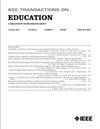Leadership Growth Over Multiple Semesters in Project-Based Student Teams Embedded in Faculty Research (Vertically Integrated Projects)
IF 2.1
2区 工程技术
Q2 EDUCATION, SCIENTIFIC DISCIPLINES
引用次数: 0
Abstract
Contribution: This longitudinal study modeled student leadership growth in a course sequence supporting long-term, large-scale, multidisciplinary projects embedded in faculty research. Students (half from computer science, computational media, electrical engineering, and computer engineering) participated for 1–4 semesters. Background: Project- based learning (PBL) is used widely in higher education. It is used in industry for leadership development, but leadership development in project-based learning (PBL) has not been explored in higher education. A preliminary analysis implied leadership growth through the third semester of participation, but the design did not control for attrition. Research Questions: At the student level, how do leadership role ratings change over multiple semesters of participation? Do first (and second) semester ratings differ by number of semesters students eventually participate? Methodology: The study involved two peer evaluation questions on 1) the degree to which students coordinated the team’s work and 2) served as technical/content area leaders. Analysis employed analysis of variance to examine attrition by initial ratings (N = 1045) and multilevel growth modeling to study change over time (N = 585). A strength of using peer evaluations is the large sample size, but a weakness is that the tool was developed for student assessment and not educational research. The study did not control for participation in leadership programs outside the course. Findings: On average, individual leadership role ratings increased each semester through the third semester of participation. Ratings of students who left the program after 1 or 2 semesters did not differ from ratings for those who participated longer.嵌入教师研究(纵向整合项目)的项目型学生团队在多个学期中的领导力提升
贡献:这项纵向研究模拟了学生在支持长期、大规模、多学科项目的课程序列中的领导力成长情况,该课程序列嵌入了教师的研究成果。学生(一半来自计算机科学、计算媒体、电子工程和计算机工程专业)参与了 1-4 个学期的研究。背景:基于项目的学习(PBL基于项目的学习(PBL)在高等教育中应用广泛。在工业领域,它被用于领导力培养,但在高等教育领域,基于项目的学习(PBL)中的领导力培养还没有被探索过。一项初步分析表明,在参与项目的第三个学期,学生的领导力有所提高,但这一设计并没有对自然减员进行控制。研究问题在学生层面,领导角色的评价在多个学期的参与过程中会发生怎样的变化?学生最终参与的学期数不同,第一学期(和第二学期)的评价也不同吗?研究方法:研究涉及两个同伴评价问题:1)学生协调团队工作的程度;2)担任技术/内容领域领导的程度。分析采用了方差分析来研究初始评价的流失情况(N = 1045),并采用多层次增长模型来研究随时间的变化(N = 585)。使用同行评价的优点是样本量大,缺点是该工具是为学生评估而开发的,而不是教育研究。该研究没有对参加课程之外的领导力项目进行控制。研究结果平均而言,在参与课程的第三个学期,学生对个人领导力角色的评价每学期都有所提高。一学期或两学期后离开课程的学生的评分与参与时间更长的学生的评分没有差异。
本文章由计算机程序翻译,如有差异,请以英文原文为准。
求助全文
约1分钟内获得全文
求助全文
来源期刊

IEEE Transactions on Education
工程技术-工程:电子与电气
CiteScore
5.80
自引率
7.70%
发文量
90
审稿时长
1 months
期刊介绍:
The IEEE Transactions on Education (ToE) publishes significant and original scholarly contributions to education in electrical and electronics engineering, computer engineering, computer science, and other fields within the scope of interest of IEEE. Contributions must address discovery, integration, and/or application of knowledge in education in these fields. Articles must support contributions and assertions with compelling evidence and provide explicit, transparent descriptions of the processes through which the evidence is collected, analyzed, and interpreted. While characteristics of compelling evidence cannot be described to address every conceivable situation, generally assessment of the work being reported must go beyond student self-report and attitudinal data.
 求助内容:
求助内容: 应助结果提醒方式:
应助结果提醒方式:


